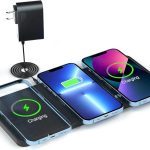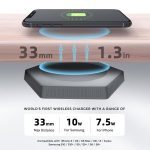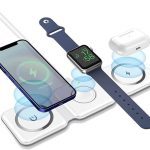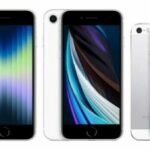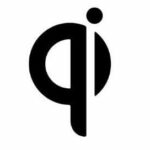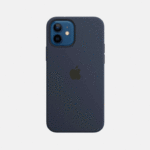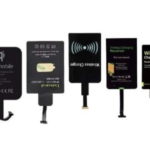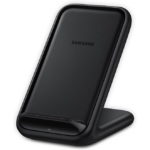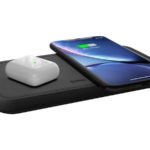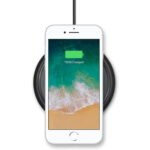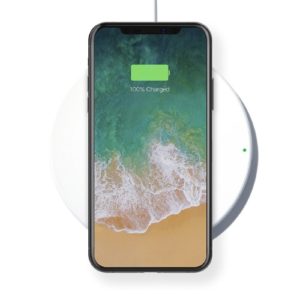 You are welcome to Qi-Wireless-Charging.net. On this page, you will find everything you need to know about Qi chargers, their trends, and their development in wireless charging for smartphones and other devices. News articles are neutral, discussing the latest Qi wireless charger events. Blog posts are about opinions, handy tips, and constructive advice. Comparison table displaying an overview of essential criteria about popular Qi chargers.
You are welcome to Qi-Wireless-Charging.net. On this page, you will find everything you need to know about Qi chargers, their trends, and their development in wireless charging for smartphones and other devices. News articles are neutral, discussing the latest Qi wireless charger events. Blog posts are about opinions, handy tips, and constructive advice. Comparison table displaying an overview of essential criteria about popular Qi chargers.
Here, you can expect the following contents:
- Latest News & Blog Posts
- Wireless Charger buying advice
- List of all Qi enabled Devices
- Qi Check: Does my Device support Qi?
Wireless Charging News 2024
Understanding Qi Charging: An In-depth Guide for Wireless Power
Understanding Qi Charging requires delving into the world of wireless power. This guide offers insights into the inner workings of this technology, how it’s reshaping our device usage norms, and what makes it integral to the future of digital convenience.
Exploring the Capabilities of Qi Wireless Charging Technology
Delve into the world of Qi wireless charging technology. Explore its capabilities, from allowing multiple devices to charge simultaneously, to silent and seamless power delivery, all on a single pad.
Understanding the Technology Behind Wireless Charging
Wireless charging employs electromagnetic fields to safely transfer energy between two objects. Through induction coils creating an electromagnetic field, a device’s battery can be recharged.
iPhone SE Wireless Charging: How it works + Retrofit MagSafe
Is it possible to charge the iPhone SE wirelessly? We have the answer and all the details on this topic. The iPhone SE, Apple’s budget-friendly entry into the iPhone lineup, may be economically priced, but it doesn’t skimp on features—it even includes many of the high-end features found in pricier models. Notably, the third-generation iPhone Read more
Fast Wireless Charging – What is that?
When it comes to wireless charging for smartphones, you quickly come across the term “Fast Wireless Charging”. But what does it mean exactly? And how can you use it? In this article, you’ll find all the info you need about the Fast Wireless Charging standard, which is basically just an extension of the well-known Qi Read more
iPhone 12 MagSafe Qi Charger: Apple announced Wireless Charger
Apple announced at Keynote 2020 the first wireless charger from Cupertino for the new iPhone 12 series. The wireless charger, which is based on the usual Qi standard, bears the name MagSafe, just like the wired charger of the Macbook. But the MagSafe Qi Charger has a special feature – it docks magnetically to the Read more
Retrofit Qi Charging: How to Upgrade Smartphones with Qi Receiver
How can Qi be retrofitted? Universal Qi adapters are intended for all smartphones with a micro-USB port. They can retrofit almost all Android devices with the Qi standard – how this looks like in practice and where the differences are with current, universal Qi receivers, we have examined in more detail in this review. Besides Read more
Best Samsung Wireless Chargers
Samsung Wireless Chargers are among the best Qi Chargers on the market; after all, the smartphone manufacturer is one of the pioneers in the field of inductive charging technology, especially Qi Wireless Charging. Samsung was already one of the first manufacturers to use the Qi-standard for the wireless transfer of energy. This development is continuing: Read more
Android 11: Wireless Charging soon even easier?
Currently, a feature in the Android 11 beta version is causing a stir – testers discovered a new hint that should make wireless charging easier to use. We took a closer look and tell you with which wireless charging station this new feature has already become obsolete. Meanwhile, Xiaomi is also introducing 40-watt wireless charging, Read more
iPhone Wireless Charging: Best Wireless Charger for iPhone
Apple revolutionized the world of mobile phones with the iPhone more or less ten years ago and brought the first smartphone into the market. Today the company, once known only for its Macs and iPod, is one of the world’s leading smartphone manufacturers. The newer generations of iPhones are Qi enabled and can finally be Read more
Qi Wireless Charging from Nikola Tesla to Wireless Chargers
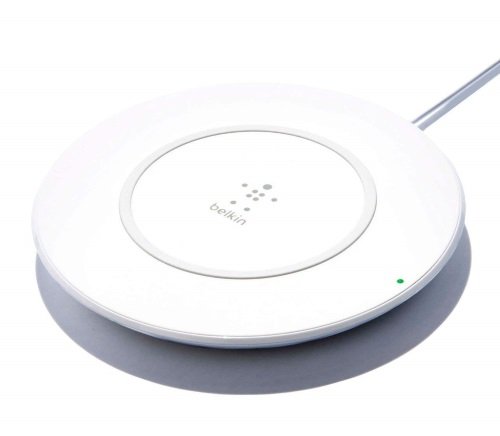
Qi is the worldwide wireless charging standard. Qi devices are compatible with Qi chargers regardless of the make. Many brands incorporated the wireless charging technique. Qi Wireless Charging is your chance to stay updated with technology in a cable-free world. Bluetooth and Wi-Fi have ensured Wireless data transfer is now a possibility. That said, the technology is yet to be fully adopted into everyday life activities. Nikola Tesla successfully transmitted electricity via induction wirelessly more than 100 years ago. However, the technology is only available to mundane devices like electric toothbrushes. Regardless, changes are being made, with Qi standard Wireless chargers gaining prominence.
This page has all the relevant information on this topic. Wireless Charging is a recent innovation, so certain considerations are necessary. Our comparison field includes bestsellers, popular products, and cost-friendly inductive chargers. In addition, we will collect important information about the product and inductive charging. You can find updates in the news category.
How does Wireless Charging work?
The charging station generates a small electromagnetic field a few millimeters above the charging surface after detecting a compatible device. Then, inductive energy is exchanged between the transmitter and receiver coils. The receiver coil transfers the current to and charges the battery. The charging process continues and is automatically terminated once the battery is full.
What is the Qi Standard?
The Qi Standard (inductive Charging) for wireless power transmission is mostly used in smartphones. It was developed by WPC (Wireless Power Consortium) in 2008 and has established itself as a top market member with over 200 companies. Its widespread use has surpassed the competing PMA standard.
The Qi standard is not restricted to specific devices or manufacturers. A Qi charging station from a particular manufacturer is compatible with all Qi devices. You can also use Qi wireless charging to exchange information between devices.
However, differences in performance exist between products from each Qi manufacturer. Samsung manufacturers are making use of the premium model that works with a field of induction charges. Samsung incorporated the use of the Qi wireless charging standard immediately after the company produced the Samsung Galaxy S6m Since then, the producers have made a unique Qi charger for succeeding models.
Qi Charger: Experience & Purchase Advice
There are varieties of wireless chargers with respect to the Qi standard. Comparing these varieties can be quite difficult for someone new to the use. You will find answers to all the questions in our test report summaries and an overview of the range of Qi chargers in the comparison table.
The website also contains information about the chargers, the technology behind them, and our experience dealing with them. You can weigh the pros and cons of Qi standard and wireless charging to know if it is worth the purchase.
There is also a list of Qi Phones where you can confirm if your smartphone supports the Qi standard or if it can be retrofitted to support it. Qi standard also works with monitors, Bluetooth speakers, smartwatches, and All-in-one PCs, which you will find in the list below.
Suppose your smartphone was not made to be retrofitted with the Qi standard. In that case, it could be retrofitted with the universal Qi receiver using a micro-USB connection and recharged with the inductive charger.
The test summary does not cover up negative feedback. If one device is unsuitable for everyday use, the reader will know from the result. We are not affiliated with any manufacturer, and our priority is to give the readers an honest report because wireless charging is not good in all aspects. You will find out more about this in the following sections.
What is a Qi Wireless Charger?
Qi wireless charger is a charger for smartphones and other devices. It is a wireless charger that uses induction to transfer power. The induction coils are responsible for transferring energy via an electric field.
Using the Qi chargers is best if many induction coils are used. This will make it comfortable to handle as it easily recognizes the device as soon as it is placed on the charger, whether it is placed in the precise position. However, the charging speed depends on the charger’s power level, so it is best to consider that during purchase.
Qi chargers come in flat forms or standalone. However, other unique Qi chargers are the Qi power banks and Qi holders for cars. The best Qi chargers are those made by renowned manufacturers, usually more sophisticated. There are some specially designed for specific phone models.
The power levels for Qi chargers are 5W, 7.5W, 10W, and 15W, but they can be higher in unique cases. Modern designs support high mode and work with each phone model’s power level. However, most of these models are not for cheap Qi chargers.
Essential Factors to Consider When Buying Qi Charger
Here are essential factors to consider when getting Qi chargers to ensure you choose the best suited:
- Performance: Qi chargers can charge at 5W, 7.5W, 10W, 15W (and sometimes more), depending on the phone model
- Design: There is the flat and standalone device
- Technology: The number of induction coils determines its handling.
- Manufacturer: Some of the best models are from Samsung, Anker, or Belkin
- Scope of delivery: Qi chargers are mostly delivered without a power supply. Specify if you want one.
Pros and Cons of Inductive Charging
Pros:
- It is practical for everyday life use
- Eliminates the use of wired connection
- It can work with any phone model, despite the manufacturer
- It can be easily used in public places like airports, cafés, hotels, and bars.
- Safer than the use of cable in public places
Cons:
- It might take more time to charge
- It can increase the rate of power consumption
- Some devices will need to be retrofitted
- It needs direct contact with the charger
- All protective covering will have to be removed during charging.
The primary advantage of wireless charging is the ease of handling. You will not have to connect a USB plug to the phone, you can just easily place it on the Qi charging station, and the charging process begins. Another advantage not listed is that it ensures the plug connection of the phone does not wear out easily. So, you get to charge your phone more often than usual and will have energy available any time and day.
The main disadvantage is that the energy transmitted is not fully optimized, as energy loss will occur during the transfer. The energy lost will be converted into heat, making the Qi charger or phone heat up. This is why some models have small fans for cooling the devices, keeping their temperature at the optimal range.
Qi Charger Design: Wireless Charging Station or Flat Charging Pad
The most common design of inductive charging devices, according to the Qi standard, is the upright wireless standing station with a flat design. This device makes it easy to watch your phone while charging it. Its primary application is to use at a desk at home or in the office.
Flat Qi chargers or wireless charging mats, on the other hand, are more suited for bedside tables or other places you can place the phone on. Wireless charging stations often have more induction coils because they have more space.
Some smartphones can have both, so you can charge the phone upright or lie down. Manufacturers like Samsung or Anker have upright charging stations for their wireless charging mats.
Another unique form of the wireless charging station is the one that can charge many devices at once; they are known as dual charging stations. This design is available for Samsung as a combination with wearables, like smartwatches or AirPods charging stations. The models can charge up to three devices simultaneously with a wireless charging mat.
Which Mobile Can Be Charged Wirelessly?
Apple iPhone Qi cell phone wireless chargingcell phones wireless charging by Qi standard – excerpt of compatible models:
- Apple iPhone 14 / iPhone 14 Plus / iPhone 14 Pro (Max)
- Apple iPhone SE 3 (2022)
- Samsung Galaxy S22 5G / S22+ (Plus) 5G / S22 Ultra 5G
- Samsung Galaxy S21 5G/ S21+ 5G/ Ultra 5G
- Samsung Galaxy S20/ S20+/ S20 Ultra
- Apple iPhone 13/ Mini/ Pro/ Pro Max
- Apple iPhone 12/ Mini/ Pro/ Pro Max
- Apple iPhone SE (2020)
- Apple iPhone 11, iPhone 11 Pro (Max)
- Xiaomi 12 / Xiaomi 12 Pro
- Huawei Mate 50 / Mate 50 Pro / Mate 50 RS
- Huawei Mate 40 Pro
- Huawei P40 Pro/ P40 Pro+ (Plus)
- Google Pixel 6/ Pixel 6 Pro
- Google Pixel 5
- Google Pixel 4, Pixel 4 XL
- LG V60 ThinQ 5G / LG Dual Screen
- LG Velvet 5G
- LG V40 ThinQ
» Click here for the entire list: Qi enabled Phones 2024
Qi Chargers for Apple iPhone and Android
The first wireless charger produced for the iPhone when Apple agreed to use an inductive charger or Qi standard was the iPhone Qi charger Belkin Boost. It was produced in collaboration with Belkin and could boost up to 7.5W.
There were speculations that there will be in-house QI chargers from California in the future, considering that Apple relies on Qi wireless charging technology for its Apple Watch, though, in this case, a unique standard.
Another concept implemented in the early model was using an induction charger to charge many devices at once. There are also Qi chargers for smartphones and smartwatches to charge them simultaneously are also on the market.
Wireless charging for the iPhone currently supports power levels 7.5 Watts, 12 Watts, and 15 Watts with MagSafe chargers.
Samsung, with its use of the Android operating system, though it was not the first to incorporate it, has been in the lead in the inductive chargers market for years. With the release of every new Galaxy series, a new Qi charger is released, and it is always a bestseller.
AirPower Alternatives: Apple Inductive Charging
The first iPhone series to adopt inductive charging is the iPhone 8 series. And from the iPhone 12 model series onwards, also with 15 watts. For higher performance, a MagSafe charger was created to ensure the iPhone 12 series sticks well to the charger, making it easy to handle the phone and specify the charging position.
Is Wireless Charging a Short Hype or Permanent Trend?
The concept of wireless charging and the convenience it brings is clearly an advantage that will be helpful for the coming technology. Since Apple has also joined the trend of using the Qi standard for the iPhone 8 series and above, it has become preprogrammed. Wireless charging has come to stay. And even though Samsung currently dominates the market and provides good-quality Qi chargers. Other manufacturers, such as Belkin or Anker, also provide reasonable quality models.
These days, wireless chargers are available for various electronic devices, extending beyond just smartphones. For instance, some robotic mowers come with a wireless charging station. In this application, the technology benefits from the ability to construct completely waterproof housings while still providing power to devices. With wireless charging, there’s no need for charging contacts that could rust or wear out.
How to Find the Best Wireless Charger
- There are currently three performance levels: According to Qi standard 1.0 (5 Watts), fast chargers according to Qi standard 1.2 (7.5-15 Watts) which is for new iPhone and Samsung models.
- Check if it has the feature Fast Wireless Charging (downward compatible)
- The number of induction coils as chargers with several induction coils makes handling easier.
- Use a sufficiently powerful USB power supply as recommended by the manufacturer.
- It is best to go for well-known manufacturers (Samsung, Apple, Anker, Belkin, or mophie)
- Many Induction chargers are delivered without a power supply unit. You should check if the power supply unit is powerful enough as it depends on the product description. But for Fast Wireless Charging it is mostly 9V/2,77 A (25 Watts) for Samsung or 9 V/2,56 A (20 Watts) for Apple MagSafe.
Charging without Cables: Wireless Charges on the Move
There are a lot of benefits regarding charging without cables or inductive charging, so it is almost inevitable that it will gain recognition and be accepted. It will not only be used at home, but in commercial spaces, public places, and everywhere. It is left to everyone to decide if a Qi charger and wireless charging is a better option for them. Our role is to give you an overview of the wireless charger market and help you decide on the right wireless charger.
